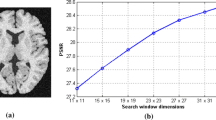Abstract
In many medical imaging modalities, the Fast Fourier Transform (FFT) is being used for the reconstruction of images from acquired raw data. The objective of the paper is to develop FFT and Inverse FT algorithms to run under GPU for performing in much faster way. The GPU based FFT implementation provides much faster reconstruction of Medical images than CPU based implementation. The GPU based algorithm is developed in MATLAB environment. GPUMat is used to running CUFFT library code in MATLAB. This work exercises the acceleration of MRI reconstruction algorithm on NVIDIA’s GPU and Intel’s Core2 Duo based CPU. The reconstruction technique shows that GPU based MRI reconstruction achieved significant speedup compared to the CPUs for medical applications at a cheaper cost.
Access this chapter
Tax calculation will be finalised at checkout
Purchases are for personal use only
Preview
Unable to display preview. Download preview PDF.
Similar content being viewed by others
References
Bockenbach, O., Knaup, M., Kachelrie, M.: Implementation of a cone-beam backprojection algorithm on the Cell Broadband Engine processor. In: SPIE Medical Imaging 2007: Physics of Medical Imaging (2007)
Mueller, K., Xu, F., Neophytou, N.: Why do commodity graphics hardware boards (GPUs) work so well for acceleration of computed tomography? In: SPIE Electronic Imaging 2007 (2007)
Mueller, K., Yagel, R.: Rapid 3-D cone-beam reconstruction with the simultaneous algebraic reconstruction technique (SART) using 2-D texture mapping hardware. IEEE Transactions on Medical Imaging 19, 1227–1237 (2000)
Chidlow, K., Möller, T.: Rapid emission tomography reconstruction. In: Int’l Workshop on Volume Graphics (2003)
Xue, X., Cheryauka, A., Tubbs, D.: Acceleration of uro-CT reconstruction for a mobile C-Arm on GPU and FPGA hardware: A simulation study. In: SPIE Medical Imaging (2006)
Virtual Imaging Laboratory, Department of Biomedical Engineering, Duke University, http://dukemil.bme.duke.edu/MRI/index.html
Liang, Z.P., Lauterbur, P.C.: Principles of Magnetic Resonance Imaging. A signal processing perspective. IEEE Press (2000)
Haacle, E.M., Liang, Z.P.: Challenges of Imaging Stucture and Function with MRI. IEEE Transactions on Medicine and Biology 19, 55–62 (2000)
Nishimura, D.G.: Principles of Magnetic Resonance Imaging (April 1996)
MRI Basics, http://www.cis.rit.edu/htbooks/mri/inside.htm
Haacle, E.M., Liang, Z.P.: Challenges of Imaging Stucture and Function with MRI. IEEE Transactions on Medicine and Biology 19, 55–62 (2000)
Uzun, I.S., Bouridane, A.A.A.: FPGA Implementations of Fast Fourier Transforms for Real-Time Signal and Image Processing. In: Proceedings. 2003 IEEE International Conference on Field-Programmable Technology, FPT (2003)
Zhuo, J., Gullapalli, R.P.: MR Artifacts, Safety, and Quality. Physics Tutorial for Residents, pp. 275–279 (2006)
Aibinu, A.M., Salami, M.J.E., Shafie, A.A., Najeeb, A.R.: MRI Reconstruction Using Discrete Fourier Transform: A tutorial. World Academy of Science, Engineering and Technology (2008)
Moratal, D., Valls-Luch, A., Mart-Bonmat, L., Brummer, M.: k-Space tutorial: an MRI educational tool for a better understanding of k-space. Biomedical Imaging and Intervention Journal (2008)
Chaari, L., Pesquet, J.-C., Benazza-Benyahia, A., Ciuciu, P.: Autocalibrated Parallel MRI Reconstruction in the Wavelet Domain. In: IEEE International Symposium on Biomedical Imaging, Paris, France, May 14-17, pp. 756–759 (2008)
Schultz, G., et al.: K-Space Based Image Reconstruction of MRI Data Encoded with Ambiguous Gradient Fields. In: Proc. of International Society for Magnetic Resonance in Medicine (2011)
Stone, S.S., et al.: Accelerating Advanced MRI Reconstructions on GPUs. In: Proceedings of the 5th International Conference on Computing Frontiers (2008)
Kleut, D., Jovanovi, M., Reljin, P.D.B.: 3D Visualisation of MRI images using MATLAB. Journal of Automatic Control 16(1-3) (2006)
Author information
Authors and Affiliations
Editor information
Editors and Affiliations
Rights and permissions
Copyright information
© 2011 Springer-Verlag Berlin Heidelberg
About this paper
Cite this paper
Haque, M.N., Uddin, M.S., Abdullah-Al-Wadud, M., Chung, Y. (2011). Fast Reconstruction Technique for Medical Images Using Graphics Processing Unit. In: Kim, Th., Adeli, H., Ramos, C., Kang, BH. (eds) Signal Processing, Image Processing and Pattern Recognition. SIP 2011. Communications in Computer and Information Science, vol 260. Springer, Berlin, Heidelberg. https://doi.org/10.1007/978-3-642-27183-0_32
Download citation
DOI: https://doi.org/10.1007/978-3-642-27183-0_32
Publisher Name: Springer, Berlin, Heidelberg
Print ISBN: 978-3-642-27182-3
Online ISBN: 978-3-642-27183-0
eBook Packages: Computer ScienceComputer Science (R0)




